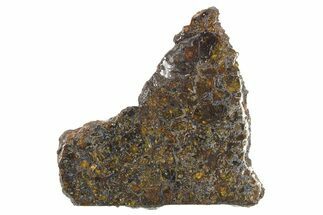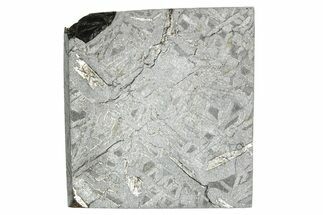This Specimen has been sold.
1.14" Springwater Pallasite Meteorite (11.8 g) - Canada
This is a 1.14" wide, Springwater pallasite meteorite from Saskatchewan, Canada. It weighs 11.8 grams.
The Springwater Pallasite
The Springwater Pallasite is a historic meteorite found in 1931 by farmers clearing rocks from a field in Saskatchewan, Canada. Locals near the strewn field collected and sold pieces of it to get by during the Great Depression. The largest mass is currently held by the Royal Ontario Museum in Toronto as a national treasure of Canada.
This pallasite has small, green to golden peridot crystals and contains the rare phosphate mineral farringtonite.
The Springwater Pallasite is a historic meteorite found in 1931 by farmers clearing rocks from a field in Saskatchewan, Canada. Locals near the strewn field collected and sold pieces of it to get by during the Great Depression. The largest mass is currently held by the Royal Ontario Museum in Toronto as a national treasure of Canada.
This pallasite has small, green to golden peridot crystals and contains the rare phosphate mineral farringtonite.
About Pallasites
Pallasite meteorites are a class of stony-iron meteorites. They were once believed to have originated at the core-mantle boundary of asteroids that shattered through impacts, but a recent hypothesis is that they are a mixture of core and mantle minerals.
Pallasite meteorites consist of olivine (peridot) crystals surrounded by iron-nickel matrix. Upon acid etching, some pallasites display interweaving structures known as Widmanstätten patterns (or Thomson lines) in the metallic matrix. These structures are iron-nickel alloy crystals, typically kamacite and taenite, that cooled over millions of years in the vacuum of space.
Pallasites are quite rare: only about 200 are known, and only four have had observed falls. This represents less than 0.2% of all classified meteorites!
Pallasite Care
Pallasites are even more susceptible than most iron meteorites to rusting and deterioration due to moisture in the atmosphere; proper care includes keeping them in moisture-free environments. This is particularly important in areas with high humidity, such as Florida. All pallasite material we sell has been stabilized in some way, which will help with this issue, but care still needs to be taken to keep your treasure in good condition. Keep pallasites stored in a moisture-free environment, preferably with a corrosion inhibitor such as silica gel beads or a dehumidifier.
Pallasite meteorites are a class of stony-iron meteorites. They were once believed to have originated at the core-mantle boundary of asteroids that shattered through impacts, but a recent hypothesis is that they are a mixture of core and mantle minerals.
Pallasite meteorites consist of olivine (peridot) crystals surrounded by iron-nickel matrix. Upon acid etching, some pallasites display interweaving structures known as Widmanstätten patterns (or Thomson lines) in the metallic matrix. These structures are iron-nickel alloy crystals, typically kamacite and taenite, that cooled over millions of years in the vacuum of space.
Pallasites are quite rare: only about 200 are known, and only four have had observed falls. This represents less than 0.2% of all classified meteorites!
Pallasite Care
Pallasites are even more susceptible than most iron meteorites to rusting and deterioration due to moisture in the atmosphere; proper care includes keeping them in moisture-free environments. This is particularly important in areas with high humidity, such as Florida. All pallasite material we sell has been stabilized in some way, which will help with this issue, but care still needs to be taken to keep your treasure in good condition. Keep pallasites stored in a moisture-free environment, preferably with a corrosion inhibitor such as silica gel beads or a dehumidifier.
TYPE
Pallasite (PMG-an)
LOCATION
Springwater, Saskatchewan, Canada
SIZE
1.14 x .78 x .74", Weight: 11.8 grams
CATEGORY
ITEM
#263182
 Reviews
Reviews












